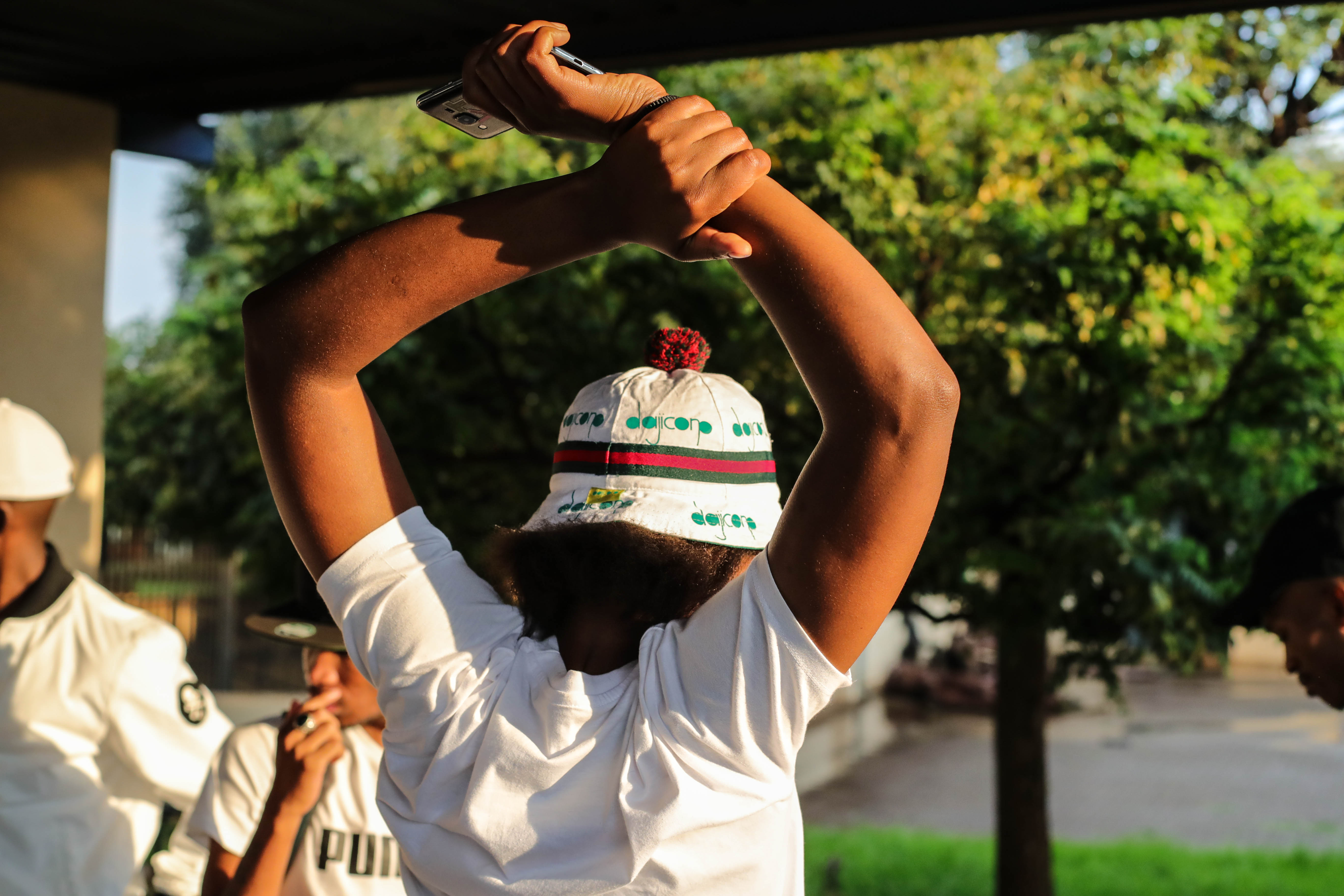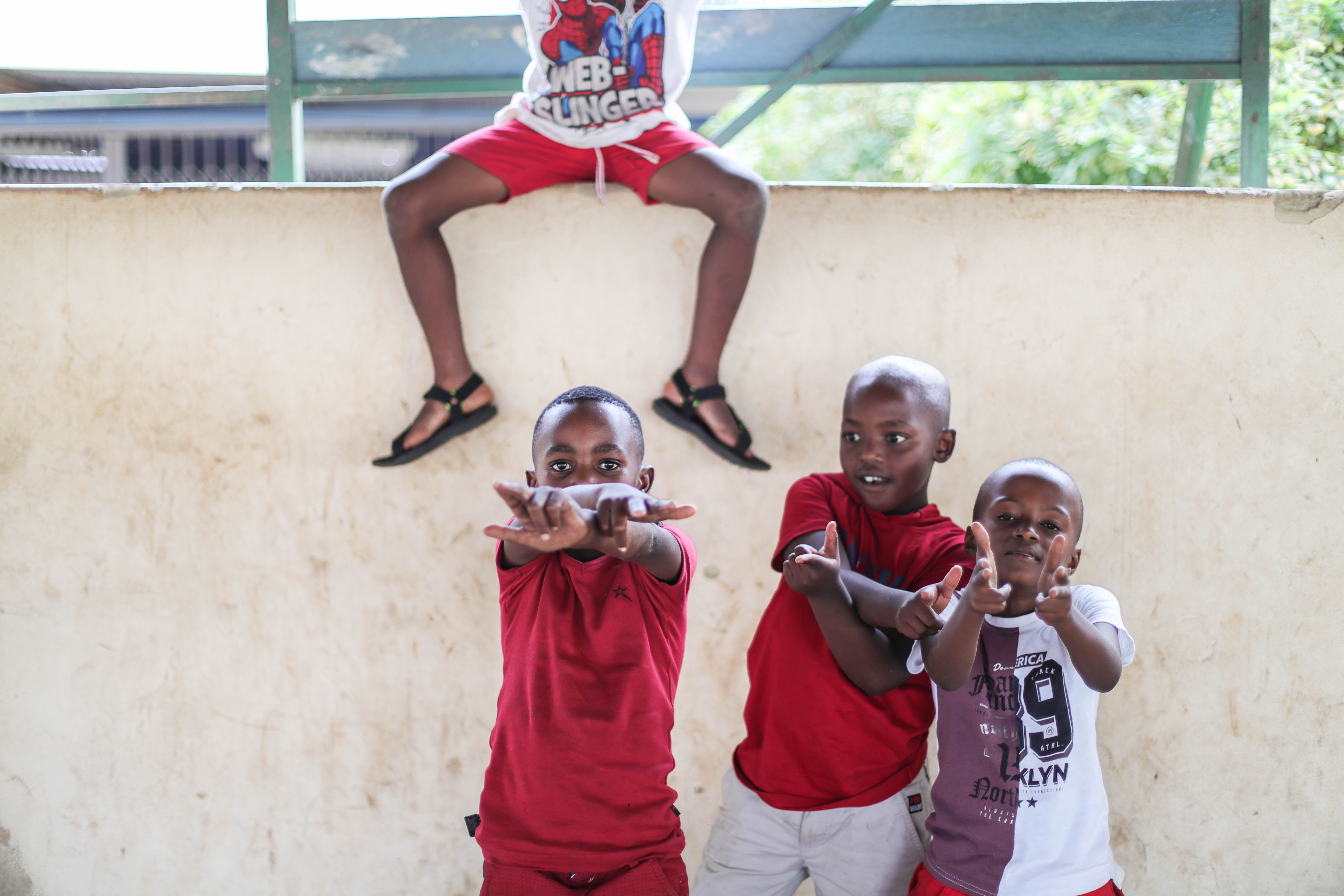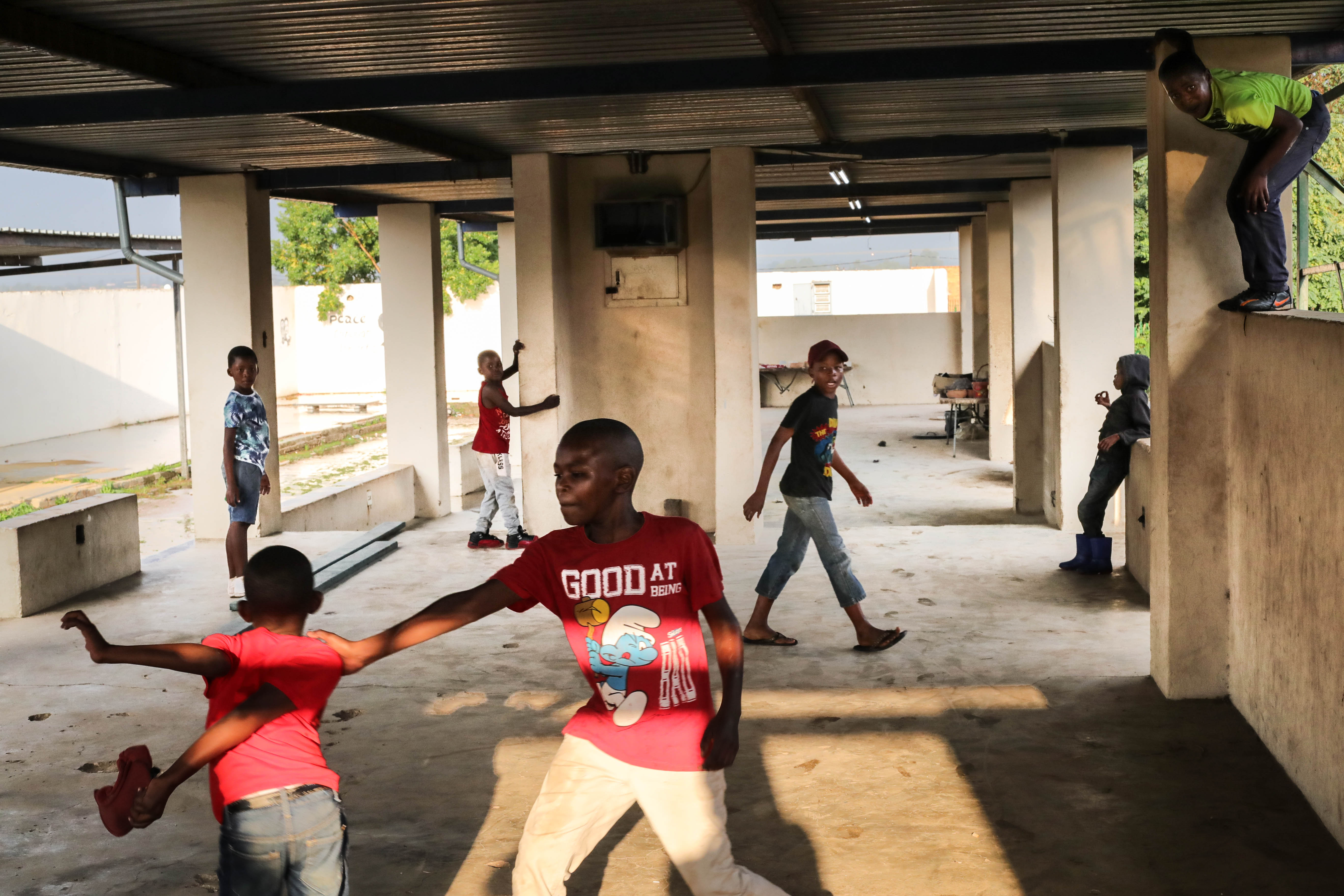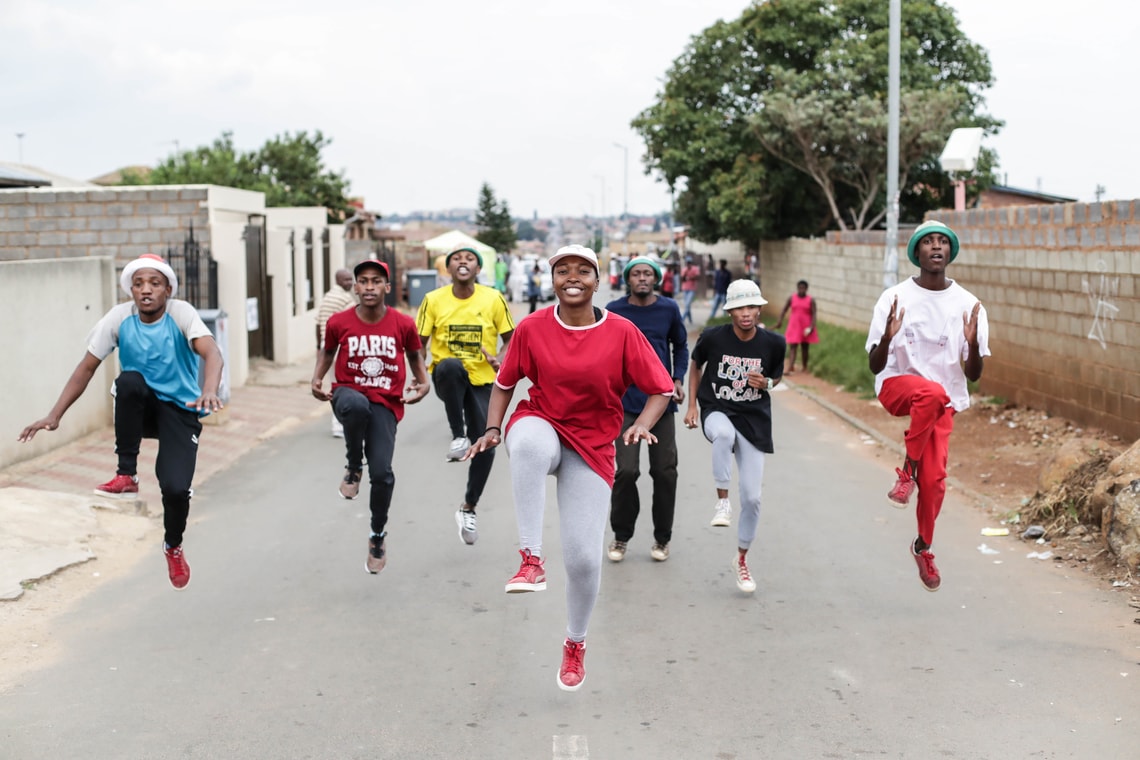This week, PAM introduces you to the contemporary faces of pantsula, the emblematic dance of South Africa’s townships. Discover the dance that goes head to head with the harsh reality. Read on for a crash course to pantsula.
Soulistic Fusion, Soweto Skeleton Movers, Pantsula Intellectuals, Tembisa Revolution, Via Broom, Rozary Productions… Within the Joburg area alone, there are at least a hundred or so pantsula crews. The dancers of these crews count in the thousands, and that’s without including those based based in Durban, Cape Town, the Free State or Botswana… On every street corner, in every town, this dance, rooted in the everyday, has set the beat of daily life for the past couple of decades. The pantsula dancer can dismantle his body, or juggle his hat with the finesse of a footballer. Footwork always reigns supreme. Whistling is also one of the myriad modes of expression of this colorfully demonstrative dance.
Over the generations, the central theme of pantsula has remained the same: transform the smallest gestures of everyday life into choreography that’s both realistic and theatrical. Everything from hiring a taxi, to playing dice, to watching out for and fleeing from police are all pretext for transforming the mundane and the demoralizing into beautiful movement. The transformation is so effective that one forgets just how much skill is needed to master the mechanics..
The history of the pantsula merges with that of Sophiatown. It’s a big, mixed neighborhood of Johannesburg, a hip spot, where writers, jive and jazz musicians and gangsters used to rub shoulders. When Sophiatown was razed to the ground in 1955 (to be renamed “Triumph” by the Apartheid regime, of all things…), blacks had to move to other neighborhoods.
“When pantsula was born it was more of a subculture that also had to do with fashion. It was young people in the 1960s and 1970s who put on British and American designer clothes, Italian shoes, and kept up with the trends in Sophiatown,” says Daniela Goeller, art historian and associate researcher at the University of Paris 1. While researching the subject, Goeller, who has travelled and researched extensively in South Africa, created “Impilo Mapantsula,” a platform that brings together choreographers and encourages a more just representation of pantsula amongst institutions. “It’s mostly a youth phenomenon,” explains Goeller. “It’s a movement that has been growing since the 1980s. Dance companies have been created and therefore so have choreographies, whereas before it was mainly a solo dance. For fifteen years, these companies and choreographies have exported themselves, most notably in France, where organizations that are ahead of the game in terms of trends, like Radio Nova, transmit and relay this urban dance.”
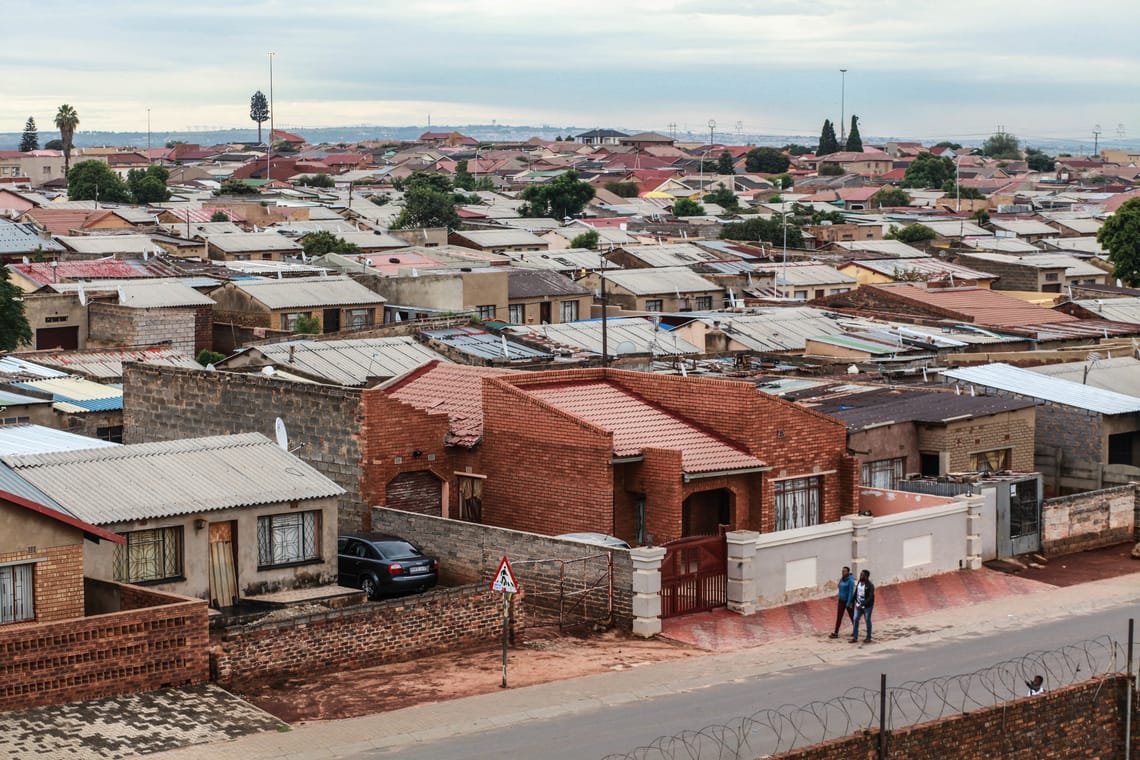
View of Tembisa, a township northeast of Johannesburg, from the Makhulong Stadium..
Half a century later, after Apartheid, the sartorial swagger of pantsula still holds its sway. Dancers display a style that is entirely South African; there are codes to respect. It’s reminiscent of the Zoot Suiters, the handsome Latino kids who were the talk of the town in the 1940s, on the US’s West Coast, and whose ultimate paragon was Kid Creole. Whether it’s a coincidence or not, the word “tsotsi,” a local adaptation of the word “Zoot Suit,” means “little criminal” in slang, and tsotsitaal is a vernacular mixture of all the languages that make up the townships. In this singularly diverse dance, Goeller suggests “a phenomenon of creolization based on South African identity.”
If the parallel with hip-hop, which has also had its own history in South Africa, is self-evident, the unique character of this dance is equally as obvious. (Editor’s note: the mixed genre of pantsula-hip hop is called isbhujwa, which phonetically is “is bourgeois.”) In its oeuvre, pantsula has integrated traces of tribal dances, like basotho, along with dance reminiscent of early twentieth-century cabarets, Harlem Renaissance’s cherished rendition of the lindy hop, the gumboot (a dance born at the bottom of the Gauteng mines), the sublime dance solos of 1950s Hollywood, and even kung-fu moves… The list of pantsula’s style influences is long, but it’s precisely what makes it so unique. Through all the artifice, pantsula tells the story of the continued harsh reality of South African townships today.
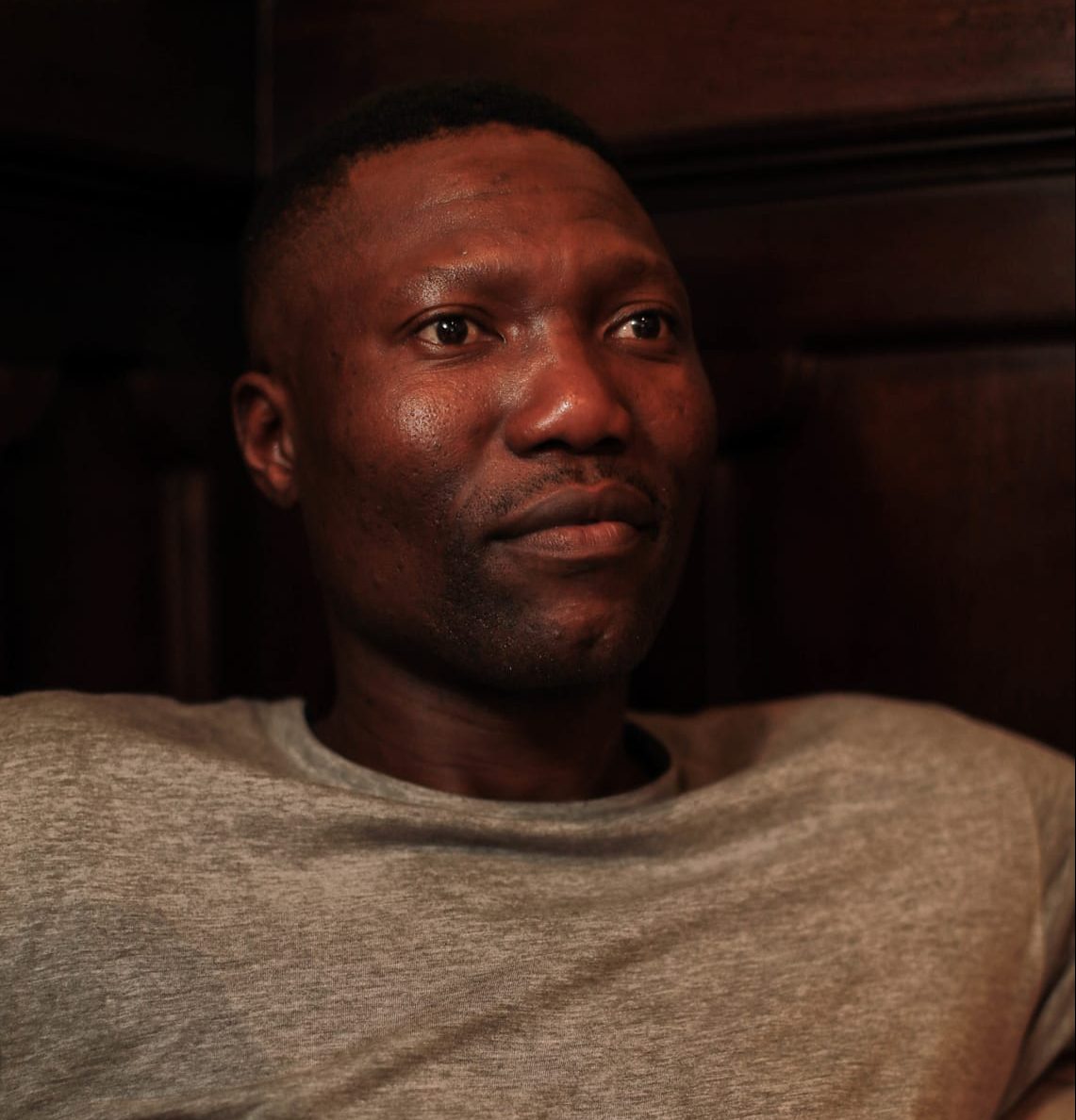
Choreographer Gregory Maqoma is one of the leading figures in South African contemporary dance today, pictured here in Rosebank, South Africa.
Greg Maqoma:
“Forget Your Harsh Existence”
“Pantsula is our pop culture. [It’s] just like hip-hop in the United States. Young people have developed a unique language with their bodies.” Before becoming a world-renowned postmodern choreographer, Gregory Maqoma was one of those kids. Born in Soweto in 1973, Maqoma affirms that, throughout the 1980s, he was influenced by both Michael Jackson and by different pantsula dances of surrounding townships. “There is a real humanity in this dance, which is rooted in forgetting the harsh reality and breaking free from the nightmare. There is also an aspect of the collective — how do we endure and bear the weight together? There is a strength; it’s a real movement.” Known for his social justice oriented choreographies, such as the formidable solo “Exit / Exist,” Maqoma draws inspiration from a powerful figure — his grandfather — who is none other than Chief Maqoma, a famous Xhosa leader who fought against the British settlers in the 1840s and was confined to the Robben Island prison, where he died in 1873. His recent choreography, entitled Via Kanana, questions power, how it corrupts and perverts the ability to think, and how it goes against the common good. Here, Maqoma refers to (former president) Zuma and similar figures. “It is in the DNA of those who monopolize power. The black bourgeoisie has benefited from economic power… “
For this piece, boosted by the beats of the boombox (a mix of abstract kwaito and reformulated jive), Maqoma collaborated with the Via Katlehong company and its pantsula dancers. He quickly ascribes his creative juices to the dance company, the “breath of fresh air” they brought and their original ideas. “For me, the technique wasn’t the most important element. They have that down. It was about harnessing all this potential and energy, bringing it to the surface, and playing around with it. Each body carries a story. Each choreography must be able to transport and emancipate the human spirit.” Since then, the show has been touring the world. It was recently scheduled for the first time in Johannesburg on February 23, 2018, a few days after the resignation of Jacob Zuma, convicted of corruption. “I have the desire to tell the truth about our reality, the environment in which we live and what we have to say! The people who live in the townships can describe it best.” That’s why, along with the pantsula dancers, Greg Maqoma cast two members of his Newtown-based company with dancers who have a first-hand, lived experience of the harsh township reality. The anchoring in the real world is essential. “Leaving South Africa is off the table, no question about it. I am here to participate in democratic change and inspire the new generation to find new spaces for expression and to no longer be a spectator, but an actor in this process. This is what Via Kanana is about. Because it’s interpreted by the “born free” generation, those born after apartheid, it takes on an even more critical stance.”
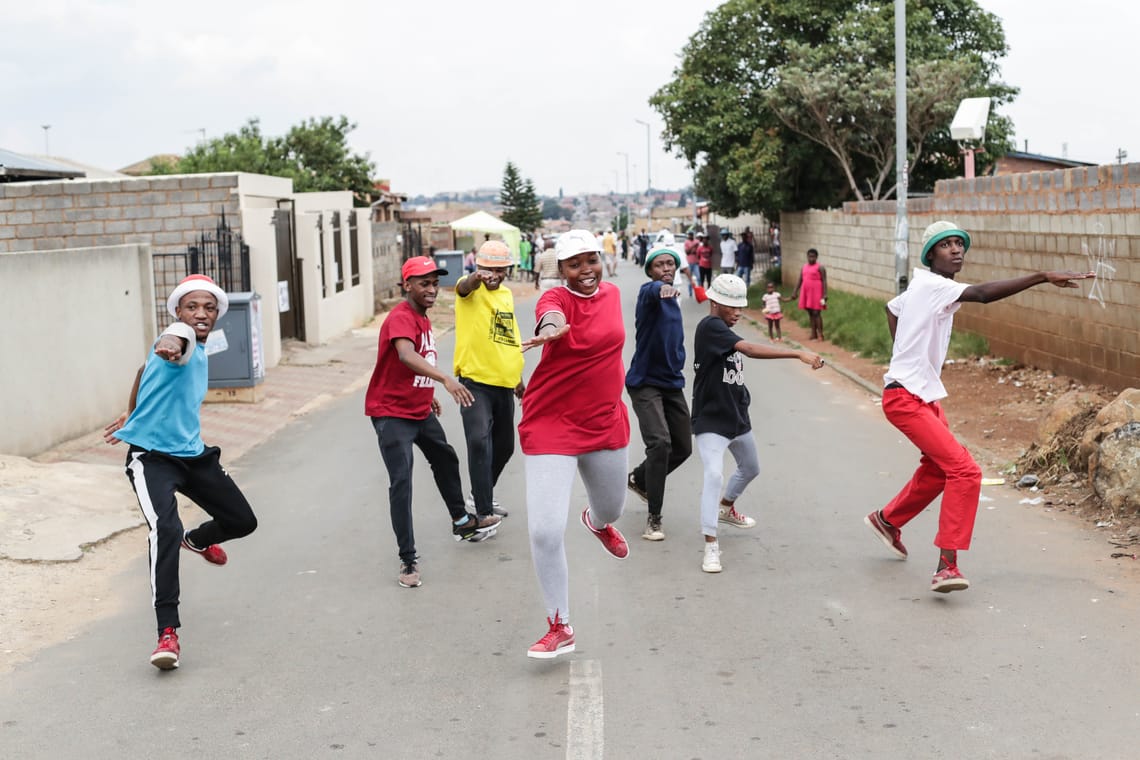
Lenela Leballo’s dance company in Soweto..
Lenela Leballo:
“A Place For Girls”
We meet Lenela Leballo on a Sunday afternoon in a park at the edge of Naledi, the district of Soweto where she grew up. She’s surrounded by her crew, the Intellectuals Pantsula, a dance group she co-founded and directs. “Our style is different from the classic style that we see in the street. We’ve added more acrobatics and some breakbeat.”
At the young age of twenty-three, Leballo already has more than ten years of practice under her belt and is living proof that girls are now entering the pantsula dance arena. “Lee” began dancing in 2007 in an all-girl group. Today she stands by her statement that pursuing dance, and the arts in general, is not encouraged by society at large, or even by one’s own family. “In the black community, girls are more likely to pursue an education, with “professional” jobs, not a career in the arts. As a result, few girls make the leap to follow their dreams.” Leballo obtained her high school diploma, but did not have the means to go to university (her father works in construction, her mother is a housekeeper). She ended up going pro in 2013. Five years later, she is bringing it to the stage, even outside of her native country. To break into this scene dominated by men, and still very much imbued with macho references, she had to buckle down and get to work. “Pantsula was created by men, and it remains dominated by them. Even if girls join the group, many fizzle out. There’s a pervasive, false mentality that suggests that pantsula is too hard for us [girls]. It’s very physical, but I’m proof that it’s possible.”
Learn your pantsula dance moves here
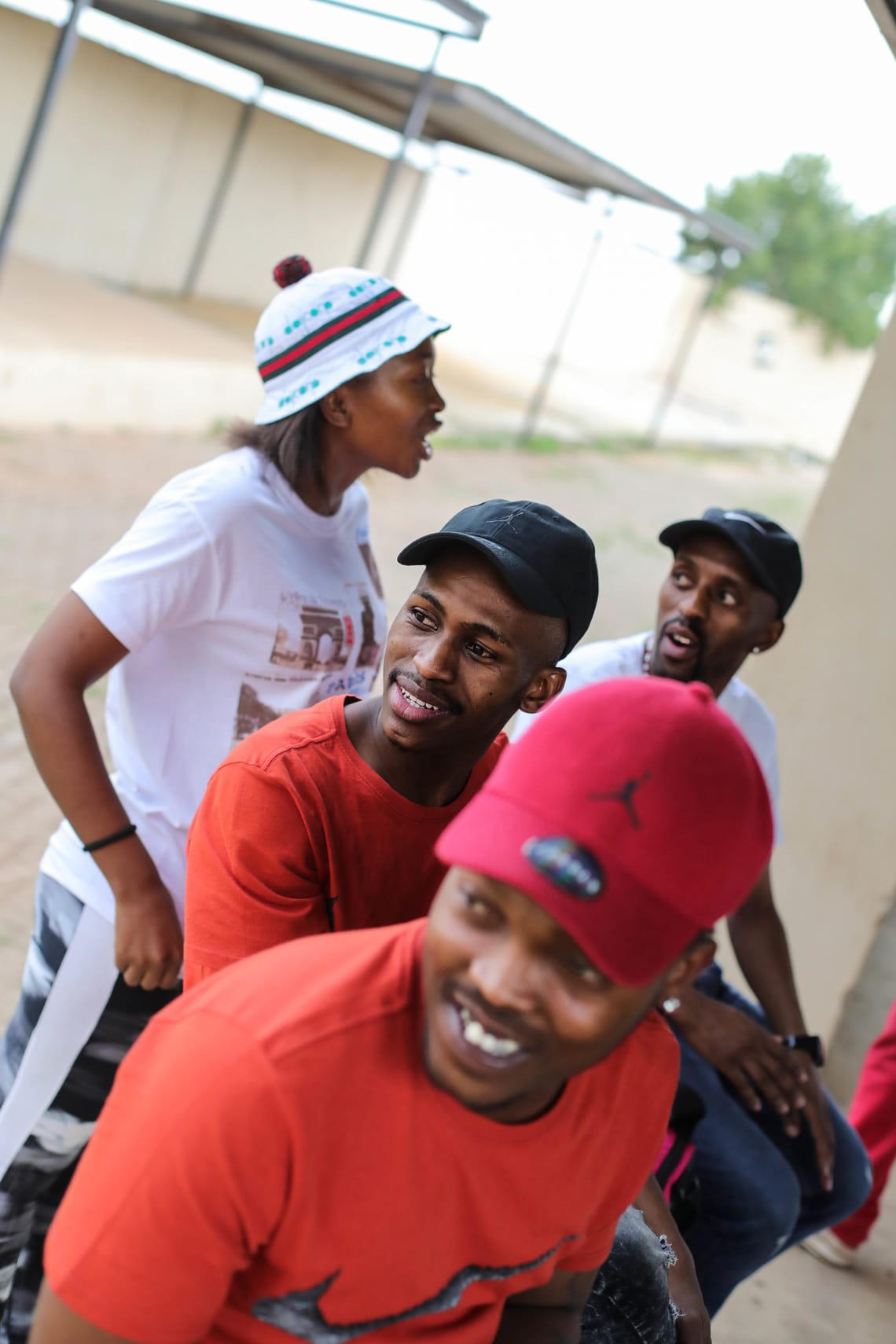
At Katlehong’s cultural center, with the Via Katlehong dance crew.
Thato Qofela:
“Dance on to the Straight and Narrow Path”
Thato Qofela got into pantsula young. At the age of five, he wanted to follow in the footsteps of his older brother Thabo “Masapo” Qofela, who was one of the founders of the dance company Via Katlehong. “His specialty was dancing like a disjointed puppet, and that’s where he got his nickname…Masapo means ‘bones’!” These days, his brother is more about music than dance, opting to produce kwaito, which, along with house, are the main music genres of pantsula. Thato, however, has continued to put his nose to the pantsula grindstone. At eleven, he had already held his own on stage with a group of older dancers.
By 2007, Thato was on his way to his first tour in France. It was a definitive sign of a successful path ahead, especially given his modest upbringing, with an unemployed mother and factory-worker father. At twenty-nine, Thato has not forgotten the struggle.
“In Katlehong, there are far fewer riots and violence than when I was a kid. As a child, I would often cross corpses on the way to school. We had no therapy; we had to live with it. In other words, it was not easy to concentrate or to study. I do not wish on anyone the experience of growing up the way I did, in this criminalized environment. There was a lot of poverty, a lot of drugs, but that builds strength of character. In this context, dancing keeps you on the right path.
Like others in the pantsula scene, he has a predilection for certain brands of clothing: Dickies trousers, Brain Wood t-shirts, Converse sneakers, Gucci caps… Qofela asserts that it’s still common practice for people to get arrested or to be subject to more controls simply by dressing this way. “Pantsula is still associated with the image of thugs, especially in white people’s minds. But even though pantsula was born and evolved in black neighborhoods, the dance is not defined by race: everyone is welcome!”
Ready for dance lesson part two? Learn more moves with Thebza Diphehlo, here
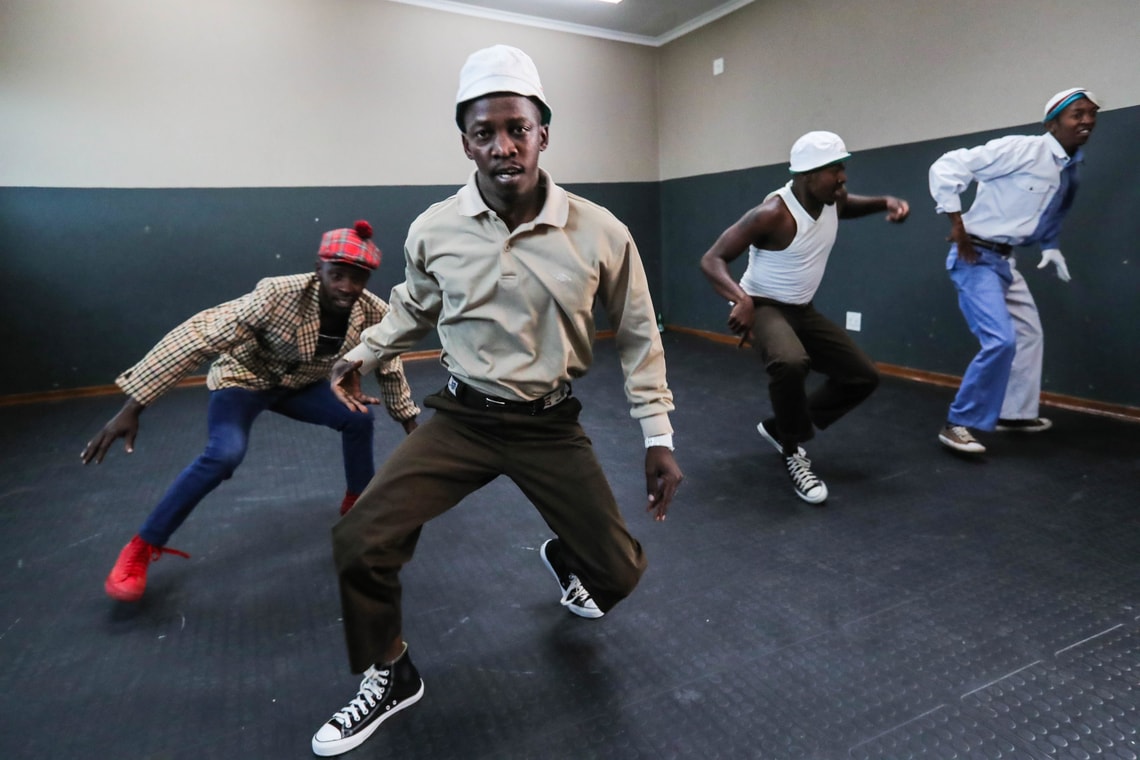
The Tembisa Revolution dance company at the township’s cultural center, east of Johannesburg, cofounded by member of Via Katlehong, choreographer Abel Vilakazi.
Abel Vilakazi:
“A culture of resistance”
They follow a series of choreographies, timed to perfection, in a small space that serves as a rehearsal room. It is in this community center, which faces the football stadium, that the Tembisa Revolution regularly meet in order to develop their show. Tembisa is a large township, halfway between Pretoria and Joburg, where Abel Vilakazi grew up. Today, the young thirty-something is at the head of this crew of eight dancers.
In 2003, at the time when the company was created, he already had been practicing pantsula for six years. Since then, he hasn’t stopped. “What was a hobby then is now a job, and we work hard. It’s also a source of income for one’s family, and most of the members of the crew still live with theirs. We have participated in TV shows, even on national TV, in ads and commercials too, but the main activity is the competitions between the different pantsula groups.” The big prize can be upwards of 25 000 rand (1,700 euros) if they win the first place…
“Pantsula probably speaks more to younger people than gumboot or other more traditional dances. [I think young people are attracted to] our attitude, the passion that we put on the stage, our way of dancing, and the music itself…”
While all dancers agree on pantsula’s parallels to hip hop, none forget to mention that pantsula came first. (It was born in the 1950s.) “This dance is a way of expressing oneself, a way of opposing apartheid, of affirming a culture … It’s a way of talking to each other without being understood by the cops, and it goes back to our grandparents. There was a political dimension. It was a form of resistance to the dominant culture. This is still the case today!” It’s an art form as well as a social expression. It’s an expression of communities that continue to be forced to survive on the periphery of the system. The glass ceiling has yet to be shattered and the fight against prejudice is far from over in the land of the rainbow nation. “We transmit values to the youth generation. Pantsula has an educational dimension. It leads the way and encourages others to follow suit. We are trying to create a revolution in the way we think, we are also focused on trying to prevent drugs — nyaopé is a strong temptation for many.”
As we wrap up, around 4pm, Vilakazi heads off to the primary school where he teaches several times a week, in between pantsula-ing. Education is power.
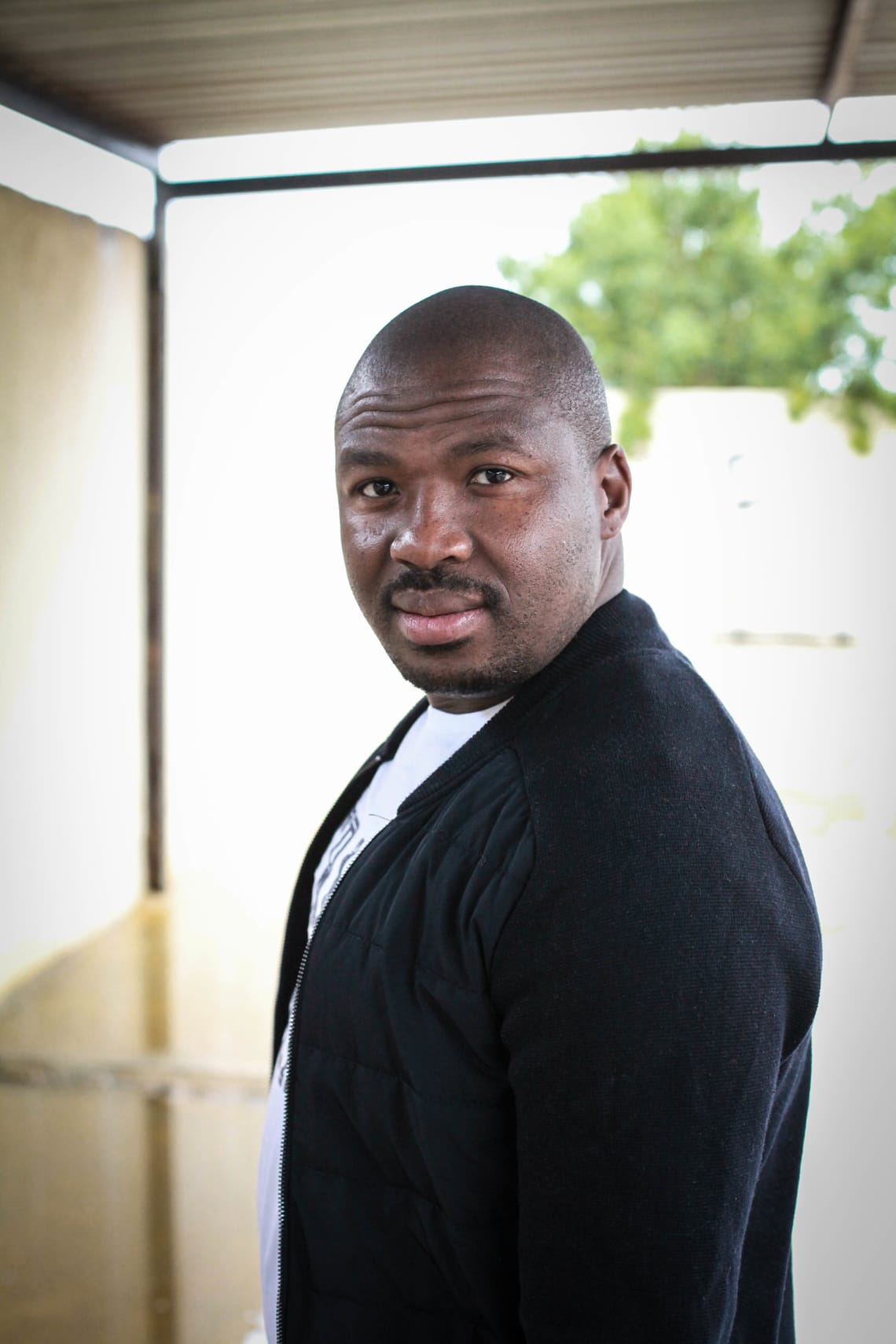
Choreographer Buru Mohlabane at Katlehong’s cultural center.
Buru Mohlabane:
“Taking apart the clichés”
“What makes me legit is the neighborhood I come from. Katlehong is a part of us, and I think we’re inspiring lots of kids here. We contribute a lot to our community and we’re here to change the image of this neighborhood — even to change the image of the country itself.” Behind Buru’s benevolent smile is a deep determination to change the status quo. It’s this desire for change which inspired the name of the dance company, Via Katlehong, in which he is one of two artistic directors. Prejudice still stings in this township south-east of Joburg, which was strongly associated with the violence during apartheid, particularly because of the tribalism that pitted the black communities against one another (Buthelezi’s Inkhata and the ANCs regularly clashed). It was in Katlehog, four years after the company was founded with four dancers in 1992, that Buru joined. The company was housed in a large arts center for the community. Buru rails against the stereotypes:”The pantsula culture was associated with gangsters, but not everyone was a gangster. Are all Italians part of the mafia?” All the meanwhile, Buru admits that dance saved his life.
Under his direction, Via Katlehong has toured the world, and has even performed in productions with illustrious jazz musicians, such as Archie Shepp or, most recently, Shabaka Hutchings. With twenty professional dancers, and several more young dancers in training, the company has become a symbol of success, and an example for all. “Nevertheless, there is still no official recognition of these dances. There is no school, no diploma, and therefore very few professional prospects. Thanks to our discipline and our our will, we were able to reach a level that allowed us to gain recognition abroad.” Their success is less known, however, in South Africa, where despite participation in big shows, such as the political and poetic musical Sophiatown, they still struggle to get financial backing. This is especially true in their hometown. “Township dwellers have the right to quality shows, but without the support of the government and the municipality, it’s impossible! It’s a shame that we can not show our last show, Via Kanana. We are talking about the corruption that spreads like gangrene in this country, and how it starts with our neighborhoods. So, please, help us spread the word!”
Wrapping up the pantsula choreography with the last class, this time with Teboho Moloi, also from Katlehong.
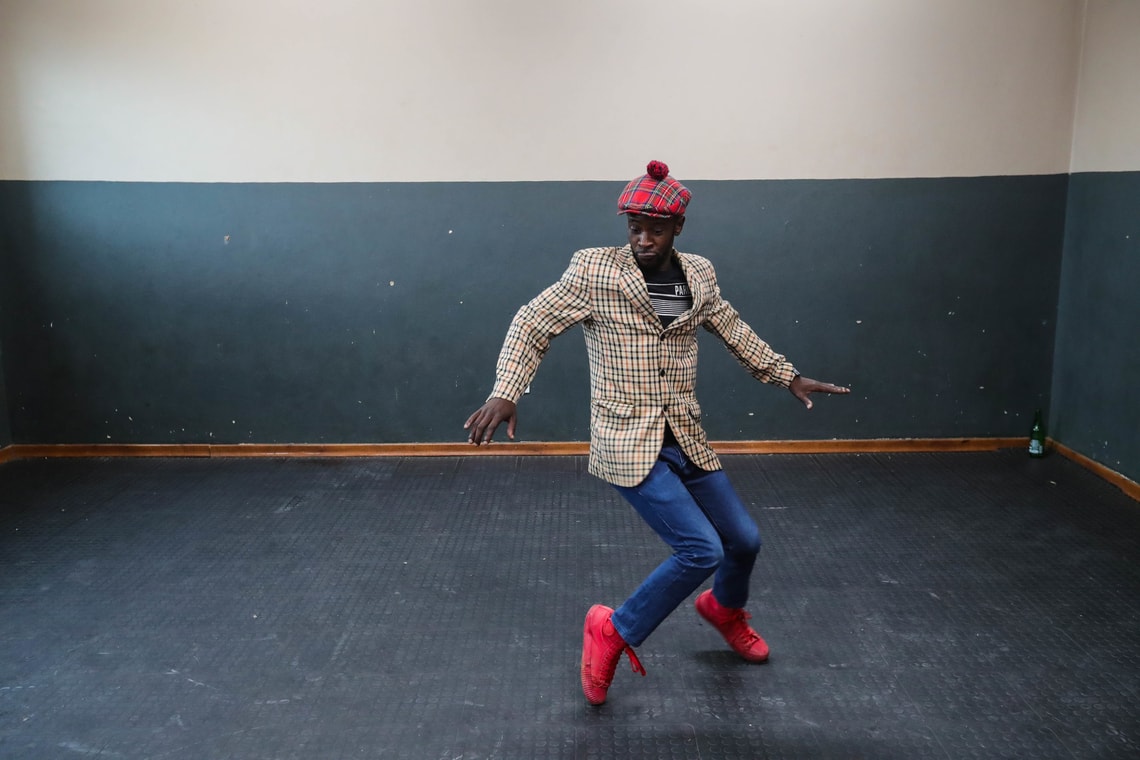
Tembisa Revolution
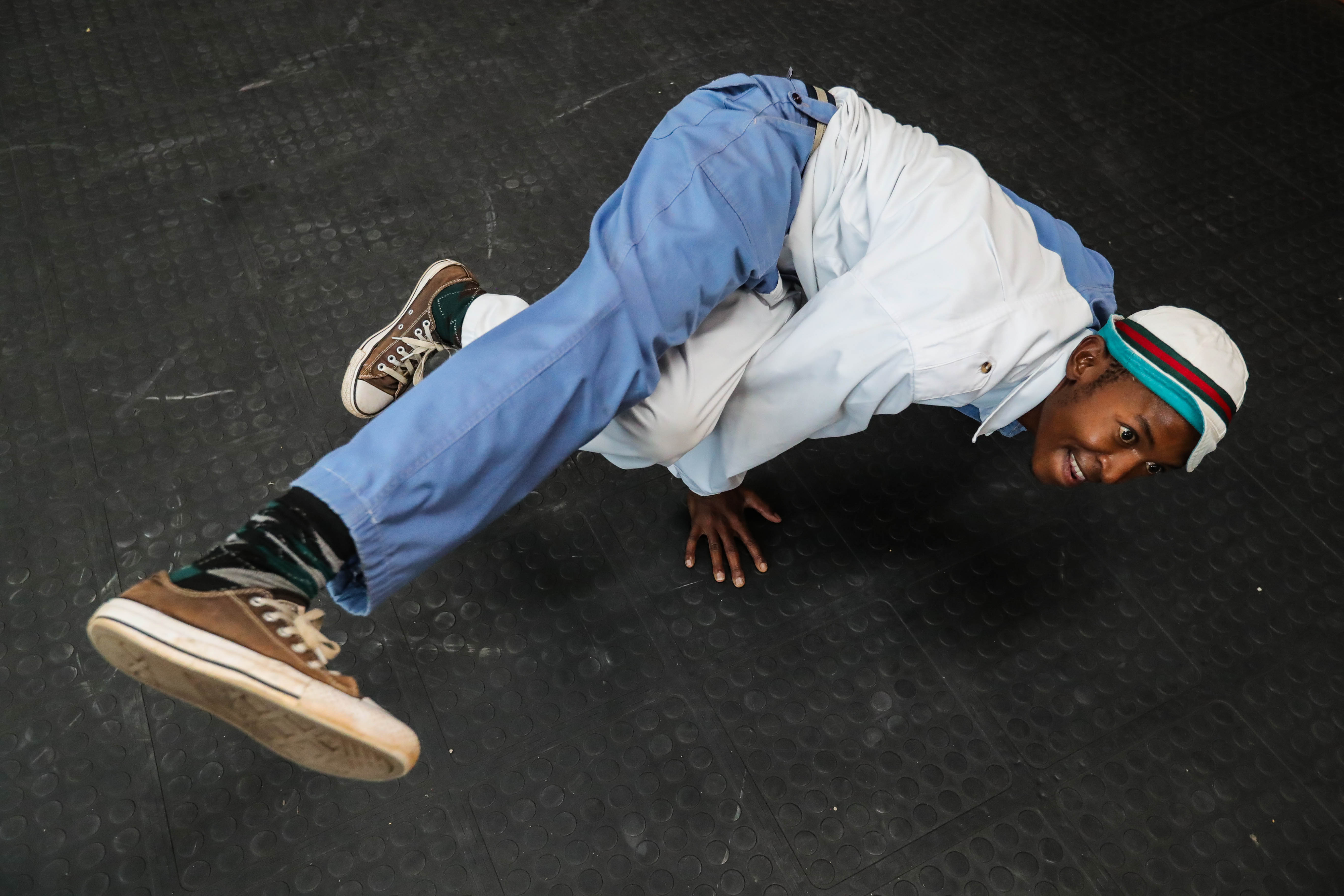

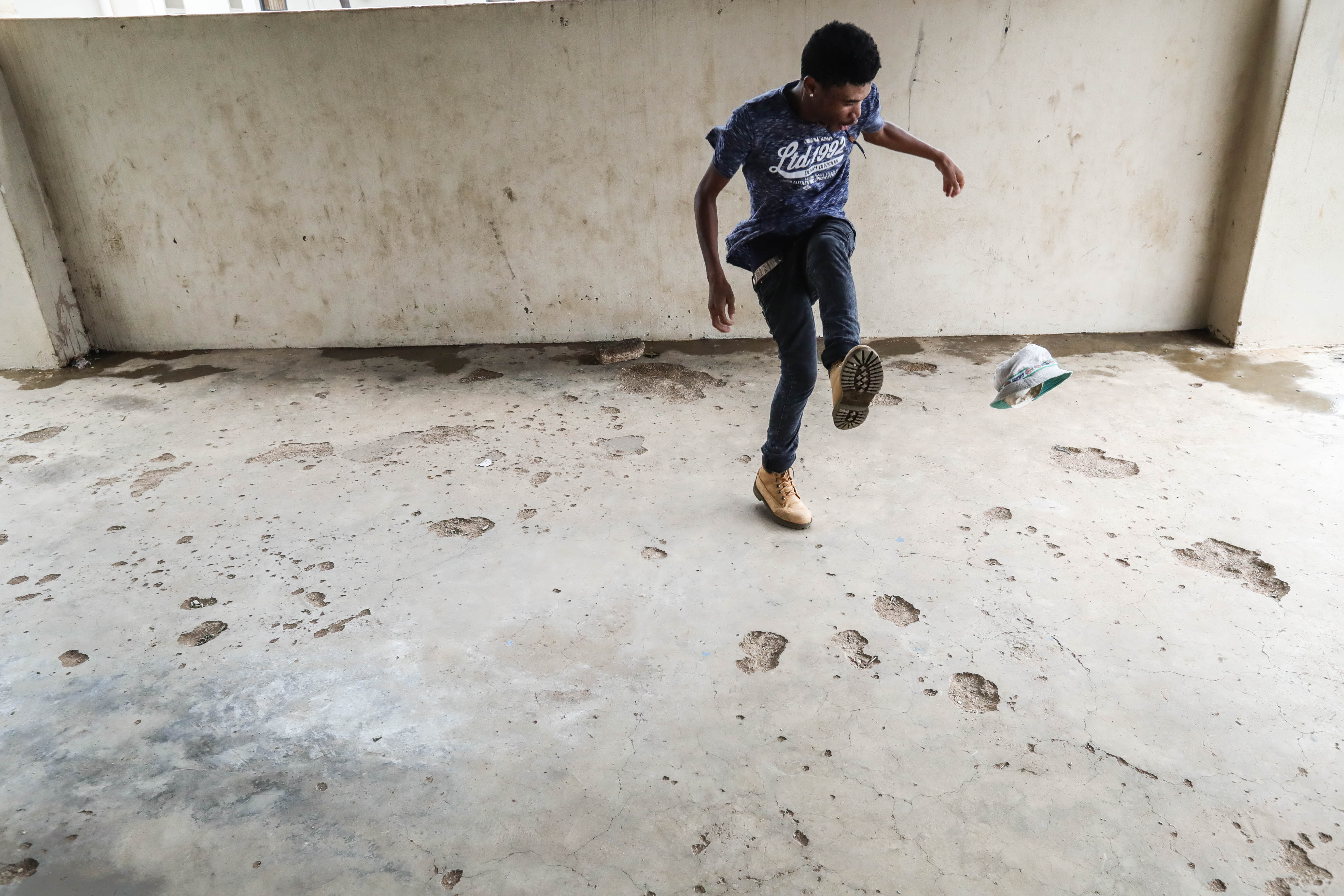
In Katlehong’s cultural center, a dancer from the Via Katlehong is rehearsing a pantsula choreography.
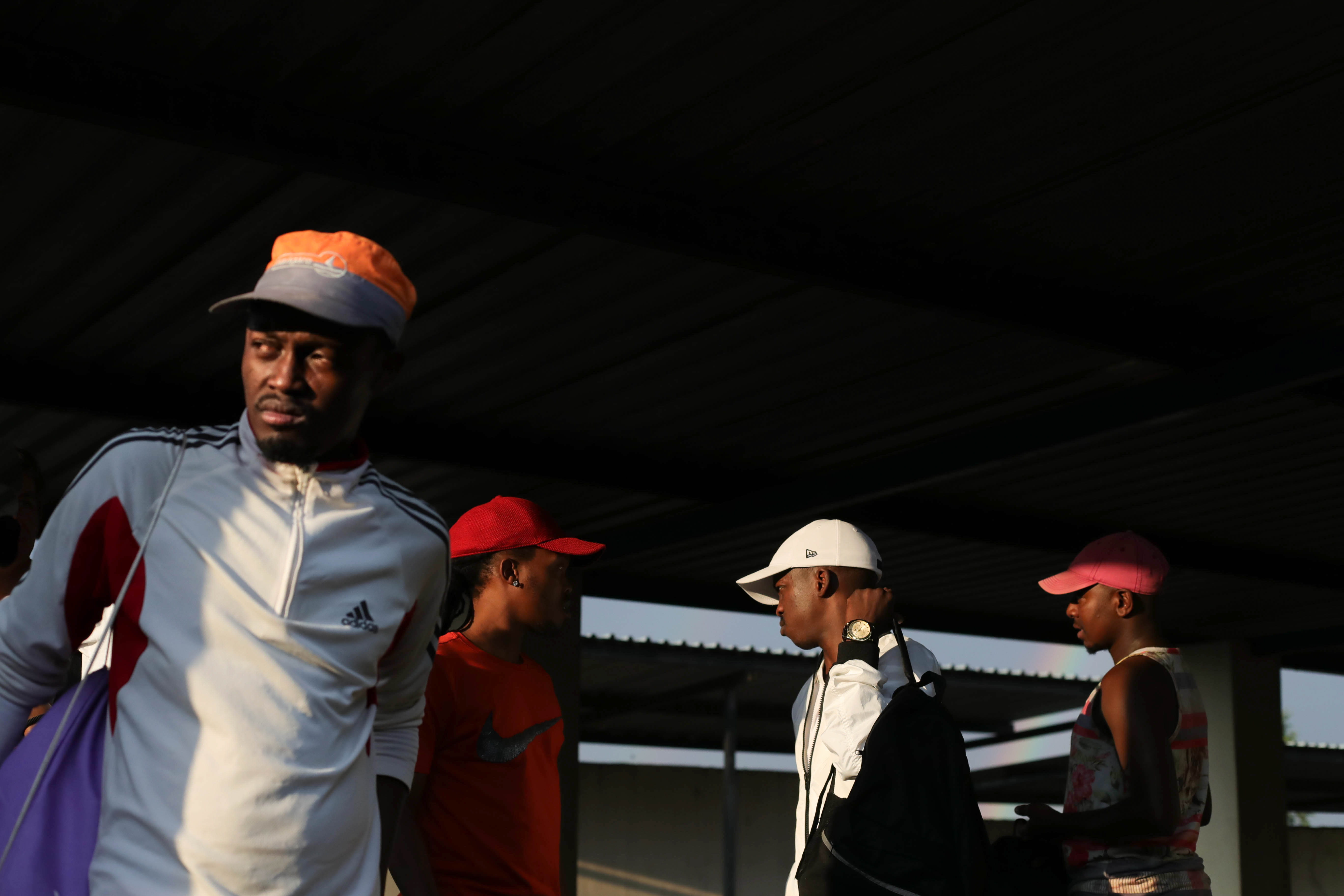
Via Katlehong
